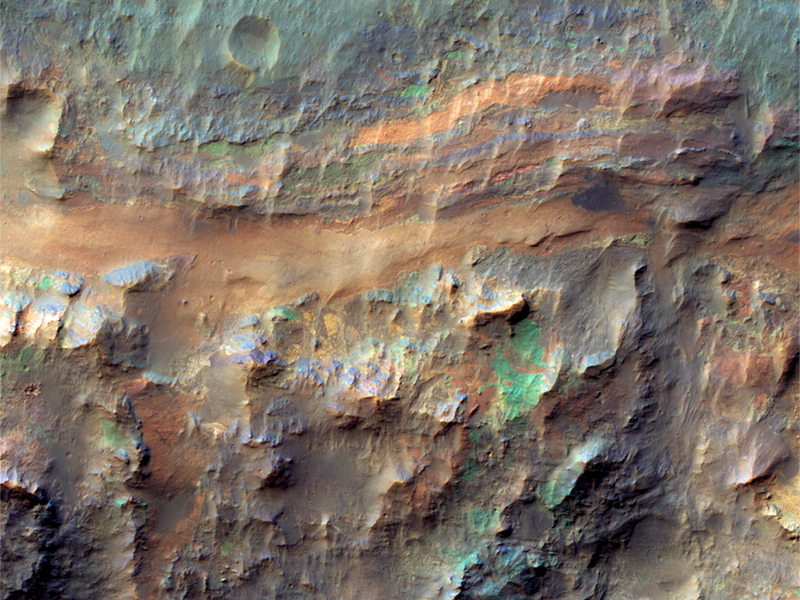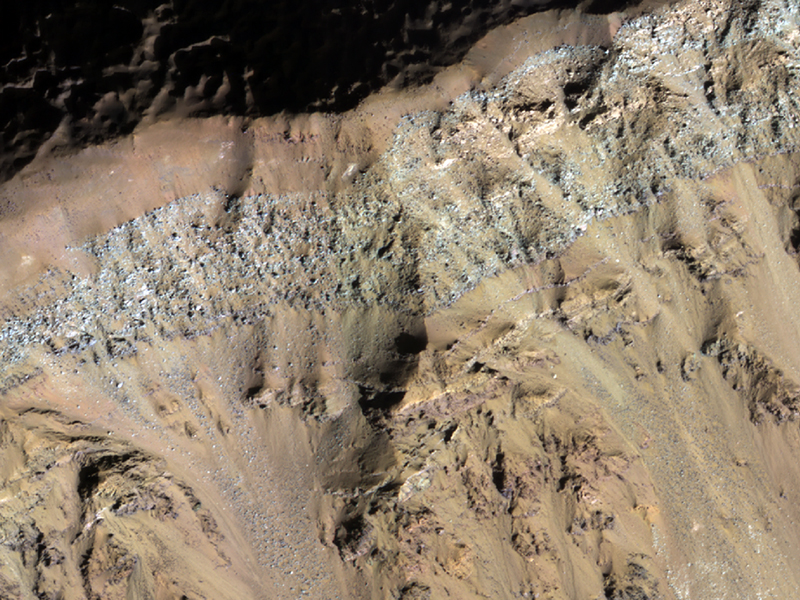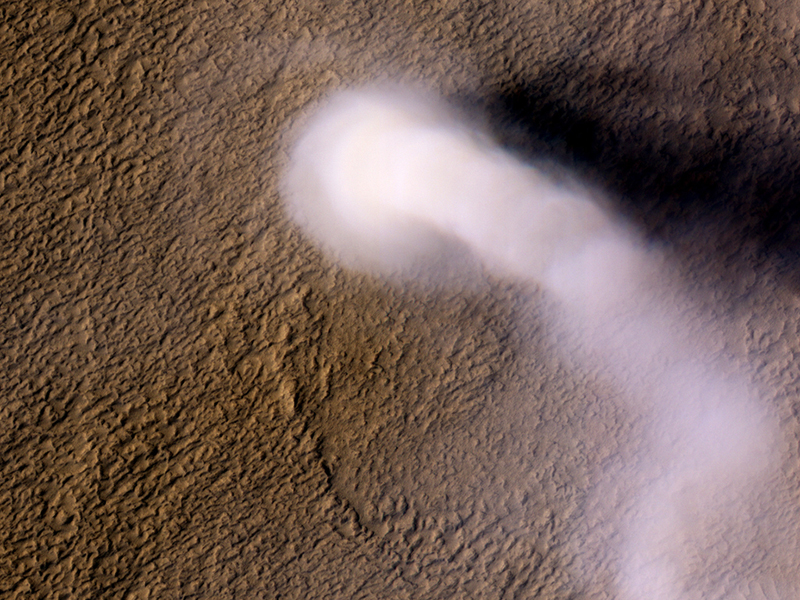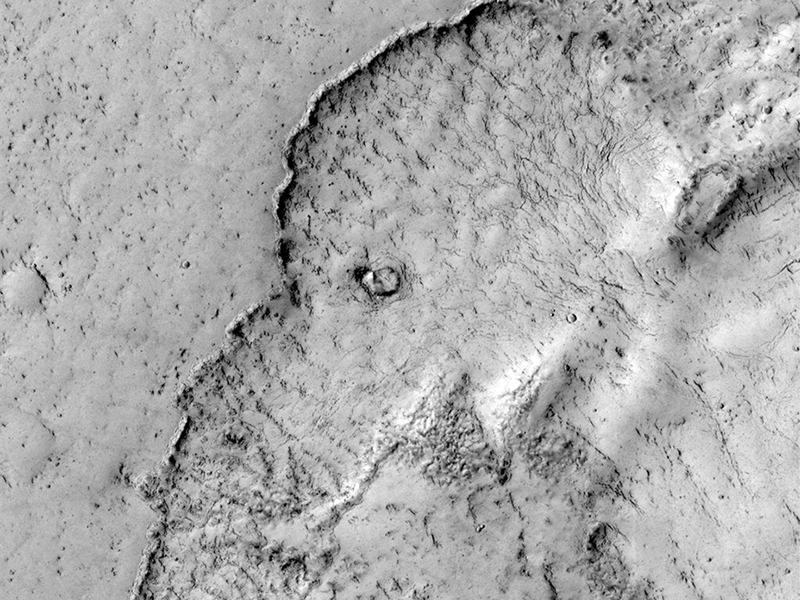Alfred McEwen wrote:Sedimentary Deposits on the Floor of Ritchey Crater (ESP_025797_1515)
Ritchey Crater exposes some of the most colorful rock outcrops on Mars in its central peak.
This image reveals comparable diversity in some of the layered sediments and jumbled deposits (megabreccia) on the crater floor. In general the blues and greens indicate unaltered minerals like olivine and pyroxene whereas the warmer colors indicate altered minerals such as clays.
Ross A. Beyer wrote:Layers in a Crater Wall (ESP_026061_1435)
This image is of the rim of a crater. The sun is low in the sky (only 15 degrees above the horizon) and shining full on this crater wall (you can see that the area beyond the rim has got long shadows).
The sun is beautifully illuminating a series of layers exposed in the crater wall which have a variety of different colors.
Note: the subimage is non map-projected, so approximate North is down.
Paul Geissler wrote:A Monster Dust Devil Stalks the Martian Landscape (ESP_026394_2160)
A dust devil the size of a terrestrial tornado towers above the Martian surface in this late springtime afternoon image of Amazonis Planitia.
Also captured by the Context Camera on MRO, the length of the shadow indicates that the dust plume reached a height of 20 kilometers (12 miles) above the surface! Despite its gargantuan height, the plume is only 70 meters (70 yards) in diameter, giving it a snake-like appearance that is twisted by high altitude winds, similar to another dust devil spotted recently in this region.
Typical tornadoes on Earth are less than 10 miles tall, while dust devils on our planet seldom reach more than a few hundred yards in height. So, why do we classify this plume as a monster dust devil and not a Martian tornado? Dust devils differ from tornadoes in their energy sources. Dust devils are driven by the heat of the surface, absorbed from sunlight and re-radiated to warm the atmosphere. The warm air rises and spins as it contracts, much as a figure skater spins faster as she draws her arms to her sides.
Tornadoes have an additional energy source: the heat given off as water vapor condenses into liquid rain. The condensing water vapor produces the visible part of a tornado, called the condensation funnel, which is made up of water droplets. On Mars, there is too little water vapor in the atmosphere to contribute significantly to atmospheric convection on local scales. The cloud that we see in this image is produced by dust particles, not raindrops. The astounding heights of Martian dust devils are made possible because mass of an atmospheric column on Mars is less than 1 percent than that of a column on Earth. Transfer of heat from the surface into this less dense atmosphere can produce more vigorous convection, which will penetrate higher into the Martian atmosphere than its counterparts do on Earth.
Now, what would happen if you were caught in its path? Because the density of Mars' atmosphere is so low, even a high velocity dust devil is unlikely to knock you over. However, you might be blasted by any sand or dust particles carried along by the dust devil, which might scratch the visor of your space suit quickly if you were caught outside by this monster!
This vortex left behind a bright track as its winds disturbed the dust-covered surface, tracing the path of the dust devil from the northwest towards the southeast. A dust "skirt" twice as wide as the plume itself is seen near the base of the dust devil, but the bright track is the size of the plume and not the skirt. Dozens of smaller dust devils were also spotted in the same Context Camera scene, steadily vacuuming the surface and pumping dust up into the Martian atmosphere.
Alfred McEwen wrote:Of Elephants and Floods of Lava (ESP_026461_2080)
This observation highlights terrain that looks like an elephant. This is a good example of the phenomena "pareidolia," where we see things (such as animals) that aren't really there.
Actually, this image covers the margin of a lava flow in Elysium Planitia, the youngest flood-lava province on Mars. Flood lavas cover extensive areas, and were once thought to be emplaced extremely rapidly, like a flood of water.
Most lava floods on Earth are emplaced over years to decades, and this is probably true for much of the lava on Mars as well. An elephant can walk away from the slowly advancing flow front. However, there is also evidence for much more rapidly flowing lava on Mars, a true flood of lava. In this instance, maybe this elephant couldn't run away fast enough.
Note: the subimage is not map-projected, so approximate North is down.
Credit: NASA/JPL/University of Arizona
<< Previous HiRISE Update



